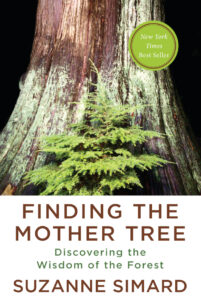
By now, most of us have heard of the controversial theory that trees communicate with each other and even help each other through an extensive underground network of fungi, connecting their roots. Learn how Suzanne Simard made the discoveries that drew her to propose this radical theory in her autobiography Finding the Mother Tree.
The story begins when Suzanne was a 20-year-old summer intern at a logging company in the Lillooet Mountain Range. Her job was to document the progress of the seedlings that the logging company planted to replace the forest which they had clearcut. Suzanne had grown up in rural British Columbia and she knew the importance of the logging industry, both to the economy and to her own family. Yet her observations made her think there was something wrong, something dysfunctional, about the way the logging company was trying to grow a forest as if it were a row crop.
The seedlings were not thriving. When she pulled up a seedling Suzanne noticed that the roots were sparse and bare. When she pulled up a seedling growing naturally in the forest, its roots were long and were attached to mycorrhiza that seemed endless. What did the mycorrhiza do? Did it somehow provide a benefit to the seedling?
After graduation Suzanne worked for the forest service and designed experiments to test her hypothesis that plants grew better as part of a plant community. Despite support from her immediate supervisor, she was ignored and ridiculed by higher-ups and logging company representatives, who subscribed to a plan called “Room to Grow” that emphasized removing other vegetation that would compete for water, nutrients, and sun. Suzanne returned to school and continued her experiments in graduate school and later as a professor at the University of British Columbia. In this book she describes those experiments and shares her conclusions that mycorrhiza connects the roots of old trees to the roots of younger trees and enables the sharing of scarce resources.
But this is an autobiography and Suzanne has a life outside the laboratory. There are also friends, love, marriage, family. She has encounters with grizzlies and wolf packs. Overcomes cancer and divorce. She has stories about rodeo, bull-riding, and buckle bunnies. Skiing and hiking in the forest and mountain sunsets.
This is an inspiring book not only for the science but for the whole story of her life. It would make a great read for anyone interested in plants and nature, and especially for young women contemplating a science career.


